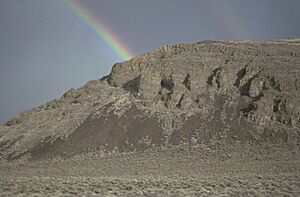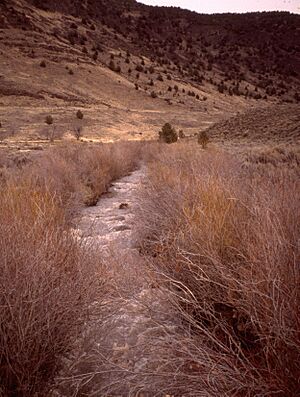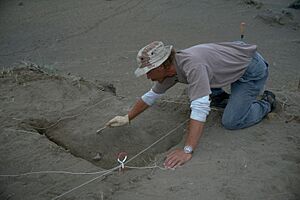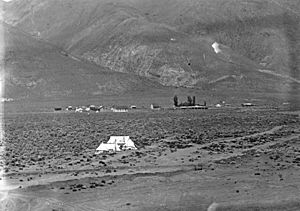Catlow Valley facts for kids
Quick facts for kids Catlow Valley |
|
|---|---|

The Catlow Valley from Catlow Valley Road
|
|
| Floor elevation | 4,554 ft (1,388 m) |
| Length | 50 mi (80 km) north–south |
| Width | 30 mi (48 km) east–west |
| Area | 1,300 sq mi (3,400 km2) |
| Geography | |
| Country | United States |
| State | Oregon |
| Region | Basin and Range Province |
| County | Harney |
| Borders on | Hart Mountain, Steens Mountain and Catlow Rim |
The Catlow Valley is a large, quiet valley in Harney County, Oregon, United States. It's in the far northwestern part of North America's Basin and Range Province. The valley is named after an early rancher, John Catlow. For thousands of years, Native Americans lived here before European explorers arrived in the 1800s.
Today, raising cattle is the main business in the valley. The Bureau of Land Management looks after the public lands in Catlow Valley. These public lands offer many fun activities like hiking, hunting, fishing, bird watching, and seeing wildlife.
Contents
What is the Geography of Catlow Valley?
Catlow Valley is in Harney County, in southeastern Oregon. This area is the northwestern edge of North America's basin and range region. The valley is about 50 miles (80 km) long and 30 miles (48 km) wide. It covers about 1,300 square miles (3,400 km2) of high desert land. The valley floor is usually about 4,500 feet (1,400 m) above sea level.
The valley has Hart Mountain to its west and Steens Mountain to its east. Beatys Butte is southwest of the valley. Warner Peak is the highest point on Hart Mountain, reaching 8,012 feet (2,442 m) high. From Hart Mountain, the land gently slopes down to the valley floor.
Steens Mountain's western edge is called Catlow Rim. This rim runs along the east side of Catlow Valley from north to south. In the north, the rim starts as gentle hills. As it goes south, it gets steeper and higher. At the valley's south end, Catlow Rim has cliffs over 1,000 feet (300 m) tall. Beatys Butte is a single peak southwest of Catlow Valley. Its top is 7,918 feet (2,413 m) high, rising 3,400-foot (1,000 m) above the valley floor.
How Did Catlow Valley Form?
The Catlow Valley is a tectonic depression, like a sunken block of earth, called a graben. It's surrounded by high, uplifted mountains formed by faults. Hart Mountain is to the west, and Steens Mountain is to the east. Together, they form a "horst and graben" feature, where blocks of land have moved up and down.
Catlow Rim is a noticeable cliff that forms the western face of the Steens Mountain fault block. It looks out over the Catlow Valley. This rim is a basalt cliff along the valley's east side. Catlow Cave is at the base of Catlow Rim, near the valley's south end. The cave is 130 feet (40 m) wide at its entrance, 50 feet (15 m) high, and 60 feet (18 m) deep. Roaring Springs Cave is another cave at the base of Catlow Rim.
Long ago, during the Pleistocene Epoch (Ice Age), the Catlow Valley was covered by a huge lake. This lake was about 50 miles (80 km) long and wide, and in some places, it was over 250 feet (76 m) deep. Today, the valley is a high-desert basin with alluvial soil (soil deposited by water). You can still see signs of the old lake, like erosion marks, gravel bars, and terraces around the valley's edges, especially along Catlow Rim.
What is the Climate Like?
The climate in Catlow Valley is typical for southeastern Oregon's high-desert areas. Summers are short, with high temperatures and very little rain. The valley gets about 9 inches (23 cm) of precipitation each year, mostly as snow. Winters are cold.
| Climate data for P Ranch Refuge, Oregon (the nearest weather station to the Catlow Valley) | |||||||||||||
|---|---|---|---|---|---|---|---|---|---|---|---|---|---|
| Month | Jan | Feb | Mar | Apr | May | Jun | Jul | Aug | Sep | Oct | Nov | Dec | Year |
| Mean daily maximum °F (°C) | 41.4 (5.2) |
46.7 (8.2) |
55.2 (12.9) |
61.4 (16.3) |
68.0 (20.0) |
76.5 (24.7) |
87.2 (30.7) |
86.6 (30.3) |
78.5 (25.8) |
66.2 (19.0) |
49.7 (9.8) |
41.3 (5.2) |
63.2 (17.3) |
| Daily mean °F (°C) | 31.2 (−0.4) |
34.4 (1.3) |
41.2 (5.1) |
46.3 (7.9) |
52.7 (11.5) |
59.5 (15.3) |
66.8 (19.3) |
65.2 (18.4) |
57.2 (14.0) |
48.7 (9.3) |
37.0 (2.8) |
29.9 (−1.2) |
47.5 (8.6) |
| Mean daily minimum °F (°C) | 20.9 (−6.2) |
22.1 (−5.5) |
27.1 (−2.7) |
31.2 (−0.4) |
37.4 (3.0) |
42.5 (5.8) |
47.3 (8.5) |
43.8 (6.6) |
36.0 (2.2) |
31.3 (−0.4) |
24.4 (−4.2) |
18.5 (−7.5) |
31.9 (−0.1) |
| Source: National Oceanic and Atmospheric Administration, National Climatic Data Center normals data, 1981–2010 | |||||||||||||
There isn't an official weather station right in Catlow Valley. The P Ranch weather station is the closest one. It's about 5 miles (8.0 km) northeast of the valley in the Blitzen Valley. The P Ranch station is 4,210 feet (1,280 m) high, which is about 300 feet (91 m) lower than the average height of Catlow Valley. It sends daily weather data to the National Oceanic and Atmospheric Administration (NOAA).
What Animals and Plants Live Here?
The Catlow Valley has many different places for wildlife to live. These include seasonal lakes, marshes, riparian areas (along rivers), grasslands, sage steppe, dry juniper forests, and rimrock (cliffs). The valley is mostly high-desert grassland with gentle hills to the north, west, and south.
Wetlands and meadows are found where water from Hart Mountain and Steens Mountain drains into the valley. On the west side, Rock Creek and Guano Creek flow from Hart Mountain. On the east, Catlow Rim has canyons that send water into small man-made reservoirs and shallow marshes. Home Creek, Threemile Creek, and Skull Creek are the main streams on the east side. Some parts of Hart Mountain and Steens Mountain have western juniper trees. You can also find aspen trees where snow collects, and a ponderosa pine grove on Hart Mountain.
Plants of the Valley
The main plants in most of the valley are big sagebrush, low sagebrush, rabbitbrush, and bitterbrush. Common grasses include bluebunch wheatgrass, bunchgrass, and Idaho fescue. Other plants like greasewood, shadscale, spiny hopsage, winterfat, and basin wildrye grow in some areas.
Animals of the Valley
Catlow Valley is home to many high-desert animals. Large mammals include mule deer, pronghorn, bighorn sheep, coyotes, bobcats, and cougars. There's also a herd of wild horses. Smaller mammals include badgers, jackrabbits, antelope squirrels, least chipmunks, and different kinds of mice and bats. Common reptiles are various lizards and snakes like gopher snakes and western rattlesnakes.
Many birds live in the sage steppes and grasslands, such as horned larks, Brewer's sparrows, and greater sage grouse. You might also see mountain chickadees, mountain bluebirds, California quail, mourning doves, and different types of owls and hawks. In areas with water, you can find dusky flycatchers and yellow warblers. The cliffs are home to chukars, white-throated swifts, and cliff swallows.
All five year-round creeks in Catlow Valley have fish. Native fish include tui chub, Lahontan cutthroat trout, and Great Basin redband trout. You can also find rainbow trout that were introduced here.
What is the History of Catlow Valley?
Early History and Native Americans
Native Americans lived in Catlow Valley for thousands of years before European explorers arrived. The valley has several petroglyph sites (rock carvings). Some of these carvings might be up to 12,000 years old.
In 1934, archaeologist Luther S. Cressman explored Catlow Cave. He found proof that Native Americans lived there as far back as the Paleo-Indian period (8,000 to 12,000 years ago). He also found items from the Early Archaic period (6,000 to 8,000 years ago). Cressman found fire pits and other signs of daily life in the cave. Later digs found stone tools, baskets, woven mats, sandals, rope, and leather pieces. The Skull Creek dunes are another important archaeological site showing at least 8,000 years of human life. Before white settlers came, the Northern Paiute people lived in the Catlow Valley area.
The 1800s
The first European explorer to enter the valley might have been John Work. He led a Hudson's Bay Company trapping trip in 1831. We know he passed through the Steens Mountain area and the nearby Warner Valley.
In 1864, Lieutenant Colonel Charles S. Drew of the 1st Oregon Cavalry passed just south of the valley. He was on a long scouting trip for the United States Army. Drew named Beatys Butte after Sergeant A. M. Beaty, one of his noncommissioned officers.
In 1865, the U.S. Army decided it needed a fort in southeastern Oregon to stop Native American raiding parties. In 1866, soldiers from Fort Boise were sent to build it. They arrived on the east side of Warner Valley in late summer. They couldn't cross the valley's lakes and marshes, so they built a winter camp on the east slope of Hart Mountain, overlooking Catlow Valley. This camp was called Camp Warner (later Old Camp Warner). The camp was in a bad spot, and the soldiers had a very hard winter. In February 1867, General George Crook visited the camp. He ordered it moved to the west side of Warner Valley. When the new camp was finished in July 1867, Old Camp Warner was left behind. Today, only two military graves remain there.
In 1865, the United States Congress approved building the Oregon Central Military Wagon Road from Eugene, Oregon, to Fort Boise in Idaho. The company building the road could claim land for every mile built. So, they planned a route through areas with good water. The military road went through Warner Valley, south of Hart Mountain (where the Hart Mountain National Antelope Refuge is now), and then east through Catlow Valley. However, the road was barely more than a trail and was rarely used.
Cattle ranchers started using Catlow Valley in the late 1800s. Peter French was the first, setting up one of his ranches there in 1872. Another rancher, John Catlow, followed in 1874. Catlow never owned land in the valley, but he grazed his cattle there. David Shirk, one of Catlow's foremen, named the valley after his boss. David was soon joined by his brother, William. In 1876, the Shirk brothers started a ranch in Catlow Valley near Home and Threemile creeks. This caused problems with French, who already controlled much of the valley's water. In 1889, David Shirk killed one of French's ranch hands in a fight over water rights. A jury said it was self-defense, but the Shirk brothers moved their main ranch south of Beatys Butte to avoid more trouble.
The 1900s
In the early 1900s, many dry-land farmers came to Catlow Valley. They were attracted by the free land offered by the federal government's Homestead Act. Newspapers also said a railroad would soon be built through the valley, which made more people interested. By 1916, over 700 settlers lived in Catlow Valley.
To support these settlers, small communities were created across the valley. These included Beckley, Delaine, Catlow, Berdugeo, Sageview, Tiara, and Blitzen. Most of these places were just a general store with a post office.
- Beckley started in 1911 with one store. A post office was added in 1912 and closed in 1926.
- Delaine was on the west edge of the valley in Lake County. Its post office opened in 1912 and closed a year later.
- The Catlow post office opened in 1914 and closed in 1923.
- The Berdugo post office opened near Roaring Springs Ranch in 1915 and closed two years later.
- Sageview was on the west side of the valley, with only a post office, open from 1916 to 1918.
- The Tiara post office was open from May 1916 to January 1917.
The largest and oldest community was Blitzen. Its post office opened in 1916. However, by 1924, only three families were left in Blitzen. By 1928, fewer than 100 people lived in the entire valley. The Blitzen post office stayed open until 1943. Today, you can only see a few old buildings at the ghost town of Blitzen.
What Do People Do in Catlow Valley Today?
Today, there are no official towns or communities in Catlow Valley, just a few scattered ranches. Agriculture is the main way people make money here. Much of the private land is used to grow winter feed for local cattle. Wells provide water for large irrigation circles and pipe irrigation systems. Because the growing season is short, the main crops are wild hay and alfalfa.
The biggest ranch in Catlow Valley is the Roaring Springs Ranch. It owns 260,000 acres (1,100 km2) of land and has grazing rights on another 800,000 acres (3,200 km2) of public land. The ranch is below Catlow Rim, where a large spring flows from the cliff. This spring feeds many ponds and meadows, providing homes for wildlife and good land for cattle. The ranch has 20,000 acres (81 km2) of irrigated meadows that produce 200 short tons (180 metric tons) of alfalfa each year. The ghost town of Blitzen is on land owned by this ranch. In 2007, the Roaring Springs Ranch won an Environmental Stewardship Award.
The Bureau of Land Management (BLM) manages all the public land in Catlow Valley. These public lands offer many fun activities like hiking, hunting, fishing, bird watching, wildlife viewing, photography, and camping. Popular animals to hunt include mule deer, pronghorn, and chukars. Several canyon streams have trout for fishing. There are no developed campgrounds, but you can camp freely on BLM land. Finding drinking water is a challenge for visitors and campers.
How Can You Visit Catlow Valley?
The closest town to Catlow Valley is Burns, Oregon, which is the main town in Harney County. Burns is about 65 miles (105 km) north of the valley. To get to Catlow Valley from Burns, you follow the High Desert Discovery Scenic Byway south. The drive takes several hours.
From Burns, you go east on Oregon Route 78 for 1.2 miles (1.9 km). Then, turn south on Oregon Route 205 towards Frenchglen. This highway crosses the Harney Basin, goes over The Narrows between Harney and Malheur lakes, and passes through the Malheur National Wildlife Refuge to Frenchglen. Continue on Route 205 through Frenchglen and over a low pass for about 4 miles (6.4 km) into the northeast part of Catlow Valley.
Oregon Route 205 is the only paved road in Catlow Valley. It follows Catlow Rim for about 35 miles (56 km) before turning east towards Fields, which is on the other side of Steens Mountain. The High Desert Discovery Scenic Byway ends at Fields.
The main east–west road through Catlow Valley is a rough gravel road. It connects to Route 205 at the north end of the valley but is not part of the Scenic Byway. After crossing the valley, this road goes west to the Hart Mountain National Antelope Refuge, 41 miles (66 km) from the Route 205 junction. This road is not open all year. So, travelers should check with the local Bureau of Land Management office in Burns or the Hart Mountain National Antelope Refuge headquarters before using it. There is no gas available along this road until you reach Plush, which is 24 miles (39 km) west of the refuge headquarters. Plush is 40 miles (64 km) east of Lakeview, the closest city west of Catlow Valley.








